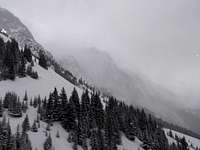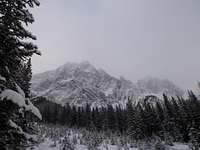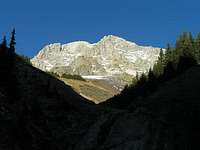-
 7082 Hits
7082 Hits
-
 79.04% Score
79.04% Score
-
 10 Votes
10 Votes
|
|
Route |
|---|---|
|
|
50.74677°N / 115.08896°W |
|
|
Mountaineering, Scrambling |
|
|
Spring, Summer, Fall, Winter |
|
|
Most of a day |
|
|
Class 3 |
|
|
depends on ascent line |
|
|
I |
|
|
Overview
Mount Hood is near the centre of the Opal Range in Kananaskis Country, Alberta, Canada. It is one of the many highpoints along the main range of the Opals that runs from Mount Evan-Thomas south to Elpoca Mountain. This handsome mountain reaches a height of 2903 metres (9,524 ft.) and is the second summit south of Mount Evan-Thomas. Like most Opal Range summits, this peak has named to honour the Battle of Jutland. Named in 1922 for Rear Admiral Sir Horace Lambert Alexander Hood (1870-1916) who was a British admiral of the First World War. His death occurred in 1916 when he went down with his ship, HMS Invincible. First ascent May 1953 by J. Dodds, W. Lemmon and others via North Ridge from Hood/Packenham col.The more famous Mount Hood in Oregon, USA, is also named for a British naval officer; Samuel Hood (1724-1816) was a British Admiral known particularly for his service in the American War of Independence and the French Revolutionary Wars. Considering the fame of the Oregon mountain, the title of this page includes the Opal Range indicator.
Getting There/Approach
Easy highway access from Highway 40 along the western edge of the Opal Range provides the best approach. Park in the King Creek parking lot, opposite the turn off for Kananaskis Lakes, approximately 50 km south of the Trans Canada Highway. To gain the West Face of Mount Hood you need to access upper King Creek, which can be difficult as there is no official trail and numerous creek crossings.An excellent trail heads up King Creek, but the trail does not have any permanent bridges. Between ice climbers in the winter, and the occasional hiker, the trail usually has many high quality log bridges, but these get fewer and fewer as you head up stream. After about 1.5 kilometres from the parking lot, the creek splits into two branches, turn north (left) and stay low, close to the creek using game trails with some light bushwhacking. About 3.5 kilometres from the left turn, you approach tree line and the Hood/King Creek Ridge Col. Access the West Face from tree line near the col.
When to Climb
Typical Canadian Rockies situation with July and August providing the best conditions for high elevation climbing. Mount Hood’s relatively low elevation and position in the dry front ranges extends the summer season and is usually dry from June to late October.Route Description
The southern portion of the West Face is generally straightforward and provides several options for ascent/descent. From grass slopes below the West Face, the standard scramble route picks a line up a scree gully, left of a steep wall, then up mostly scree to the low point of the Hood/Brock Col. From the col, head just over the ridgeline to easier terrain on the east side of the crest. Stay on scree/slab right (east) of the ridge (3rd class climbing, moderate scrambling) to the summit slopes with are scree or snow depending of time of year. Descend the same route.During an April ascent, there were questionable snow conditions on the standard scramble route. I chose a steeper line to avoid the snow, further north, using rock buttresses to avoid most of the snow, climbed several short steps up to 5.5 on solid limestone, crossing small snow slopes in between these steps. My scramble ended further north, and accessed the South Ridge closer to the summit slope (SE slope). On my ascent, the summit slope had a beautifully consistent water ice base layer and about boot top deep soft snow, crampons were a necessity. Descended the same route.
Essential Gear
Minimum climbing gear required. Long scree slog, two ski poles recommended and helmet. If snowy or icy, mountaineering axe and crampons maybe required.Rain/snow storm shell, down jacket, waterproof climbing boots and good food as required, based on weather or season.
A camera, with a charged battery, is a great idea, on my trip in April 2004, my camera had no charge and I couldn’t get any photos.
Reference
Alan Kane`s book, Scrambles in the Canadian Rockies, provides excellent route and approach information.Boles, G.W., Kruszyna R. & Putnam W.L. (1979). The Rocky Mountains of Canada South. 7 th edition. New York: American Alpine Club, Alpine Club of Canada.
Out of print










